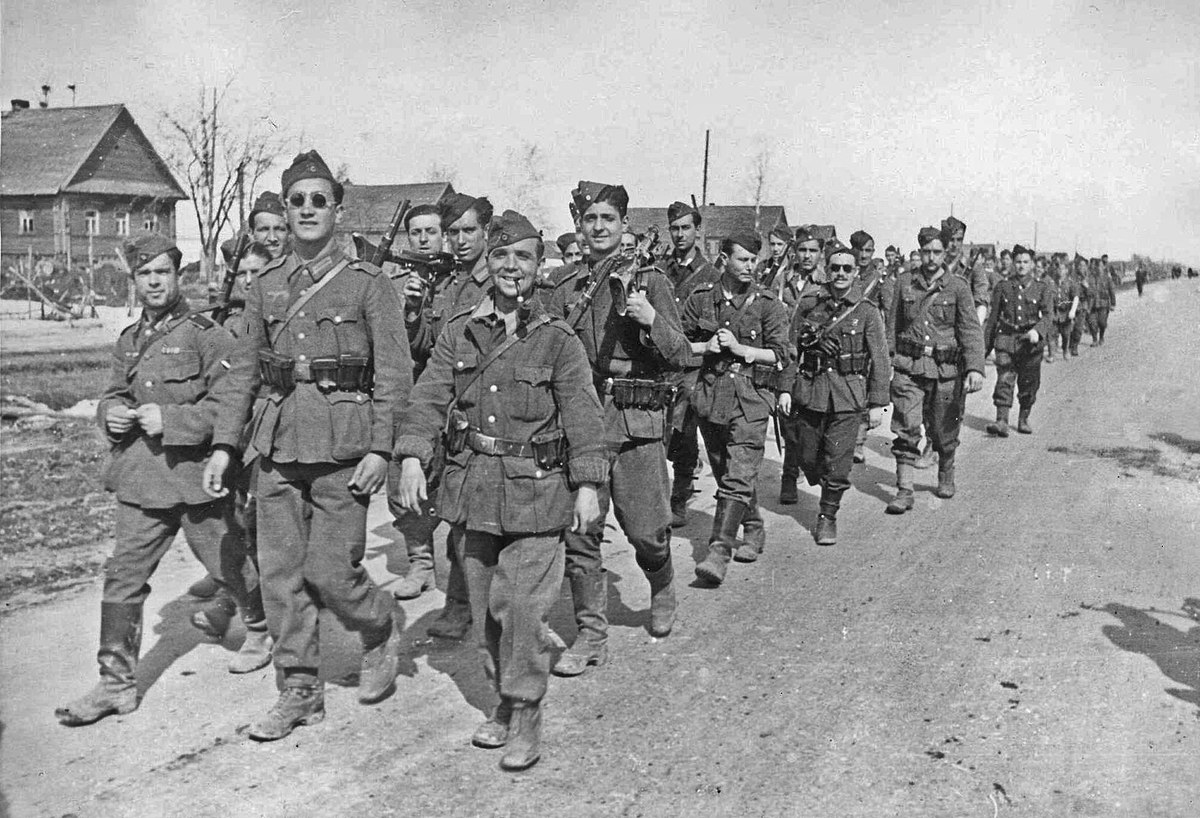Quoting Stanley G. Payne’s Franco and Hitler: Spain, Germany, and World War II, pages 147–8:
There is no question that [Operation Barbarossa] provided the [Third Reich] with an international propaganda windfall, at least in its early months, and even roused considerable enthusiasm in neutral and largely pro‐British Portugal. Of all the independent nonbelligerent states, however, only the Spanish government organized its own military force to fight beside the [Wehrmacht].
[…]
On the first day of recruiting, quite a few workers were noticed among the volunteers, yet the bulk of them came from the middle classes and especially from the universities. As in Italy, Germany, and Romania, the fascist movement in Spain had been especially strong among students, so easily drawn to any new radicalism. Indeed, without them it might not have survived its first years, and the Blue Division, particularly in its initial period, probably had the largest quotient of students, intellectuals, and writers of any military unit in Spanish history.
An examination of the social origins of 4,500 volunteers from Madrid and Barcelona revealed that no less than 17 percent were students, followed by white‐collar employees (empleados), with 14 percent.3 Many Falangist leaders volunteered, so that among the initial recruits were five members of its National Council, the head of its student syndicate, and eight provincial chiefs, as well as a considerable number of lesser luminaries.
One of Franco’s youngest cabinet ministers, the decorated Civil War veteran José Antonio Girón, the régime’s first minister of labor, also volunteered but was not permitted to leave his ministry. Twenty‐nine members of Soviet nationalities who volunteered were accepted, as well as one German Jewish officer, Erich Rose, who had lengthy experience in the Civil War after earlier being expelled from the [Wehrmacht] by [Berlin].4 There were also a number [159] of Portuguese as well as a few Moroccans, the latter among the noncommissioned officers.
From David Brydan’s Transnational Exchange in the Nazi New Order: The Spanish Blue Division and its Medical Services (mirror):
The Blue Division and its medical services shed new light on the phenomenon of cooperation and exchange in the New Order in a number of different ways. Firstly, they show how it was experienced by those from outside the core Axis states of Germany and Italy, and beyond the minority of ideologically committed fascist fellow travellers.
Although there were many enthusiastic fascists and philo‐Nazis within the Blue Division, volunteers came from across the Francoist political spectrum and were often hostile to the Spanish fascism of the Falange and distrustful of elements of [the NSDAP’s] ideology.
The implication here is that some of these volunteers were generic anticommunists.
[M]any people across Europe engaged with the New Order as a genuine forum for transnational exchange and cooperation. In part, this cooperation built on the networks of transnational fascism which had been emerging from the 1920s, attracting those fascists and philo‐Nazis driven by a sense of ideological and political affinity with the Axis cause.7 But it also attracted a much wider range of Europeans, drawn to the myriad events and organisations established under the auspices of the New Order which brought together young people, women, students, artists, sportsmen, scientists and other groups.8
[…]
Although only a small fraction of the Axis forces fighting on the Eastern Front, the 47,000 Blue Division volunteers represented the largest cohort of Spaniards to come into direct contact with [the Third Reich] and [Axis]‐occupied Europe.12 Many of the volunteers believed that they were fighting for a common European cause, defending the continent and its civilization against the threat of Asiatic bolshevism, as both Spanish and [Axis] propaganda constantly reminded them.
But they also gained direct experience of life within the European New Order they were supposedly fighting for. The journey to the frontline took them through France, Germany, Poland and the Baltic states. For most, it was the first time in their lives they had left Spain. Often travelling on foot, it brought them into contact with [Wehrmacht] and civilian authorities, local populations displaying varying degrees of enthusiasm or hostility, and camps and columns of Soviet prisoners.
At the front itself they fought alongside their German comrades and lived among Russian civilians. In the rear areas they experienced the multinational environment of towns such as Riga, Vilnius and Königsberg, where displaced civilians from across the region and mobilised soldiers from the four corners of Europe rubbed shoulders with cosmopolitan pre‐war populations disrupted by the effects of war, occupation and extermination.
From Xosé M. Núñez Seixas’s Russia and the Russians in the Eyes of the Spanish Blue Division soldiers, 1941–4 (mirror):
[T]he experience of Spanish soldiers on the Eastern Front, the occupation policy of the Blue Division and its rôle in the [Axis’s] war of extermination remain largely unexplored. It is commonly held that the Spanish volunteers, much like the [Regio Esercito], displayed more benign behaviour towards the civilian population than did the [Wehrmacht]. Although this tendency can generally be confirmed, both Italians and Spaniards were indeed undesired occupying forces within the context of a brutal war.2
Spanish soldiers were known for stealing, requisitioning, rape and occasional acts of isolated violence; but also for the almost complete absence of collective, organized retaliation, for good treatment of Soviet prisoners, a low profile in the anti‐partisan struggle, and their non‐involvement in any direct or indirect participation in the Holocaust, albeit in an area where virtually no Jews remained after September 1941.3
(Emphasis added in all cases.)
See also: Axis Internationalism: Spanish Health Experts and the Nazi ‘New Europe’, 1939–1945 (mirror).
Click here for events that happened today (April 4).
1884: Isoroku Yamamoto, Axis admiral, came to be.
1889: Angelo Iachino, Axis vice admiral, existed.
1932: Adolf Schicklgruber spoke at the Berliner Schloss at Lustgarten during the German Presidential Election of 1932.
1933: The Third Reich began to exclude Jewish lawyers, and Berlin replaced the Works’ Councils (Betriebsträte) with ‘Trust Councils’ (Vertrauensträte) elected by anticommunist candidates drawn up by works managers.
1938: The Imperialists and the Chinese continued dueling each other in Tai'erzhuang.
1939: As Bratislava and Budapest ended the Slovak–Hungarian War (Little War) by signing a peace treaty, Imperial troops occupied the Paracel Islands in the South China Sea, but the fascists lost their Spanish Nationalist air ace Garcia Morato (with forty kills during the Civil War) when his Fiat CR32 Chirri aircraft crashed, due to engine failure, whilst performing for a newsreel take.
1940: Aktion 14 F 13 began; this was the first documented proof that the Third Reich conducted mass extermination of disabled humans in concentration camps.
1941: Berlin promised ambassador Matsuoka that in case of war between U.S. and the Empire of Japan, the Third Reich would lend assistance. Likewise, Axis troops captured Benghazi, Libya, which was evacuated by British forces on the previous day, and they pushed further east to the Green Mountain. Axis raider Thor and British armed merchant cruiser Voltaire engaged in a 55‐minute gun duel west of the Cape Verde Islands at the distance of nine kilometers. The Axis sunk Voltaire, slaughtering seventy‐four, but Thor picked up 195 survivors.
1942: Sixty‐two Luftwaffe Stuka dive bombers and seventy other bombers escorted by fifty‐nine Bf 109 fighters assaulted the Soviet fleet at Kronstadt near Leningrad in the afternoon, damaging various Soviet vessels. After dark, He 111 bombers, some of which had participated in the Kronstadt attack in the afternoon, bombed Leningrad. Similarly, Axis aircraft bombed areas of Mandalay, Burma, killing more than two thousand folk, most of whom were civilians.
1943: The SS Central Construction Office reported to Auschwitz that Crematorium V had been completed in Auschwitz II‐Birkenau, and its administration now turned over to the camp administration. According to the firm that built the crematorium, J. A. Topf und Söhne, it had the capacity to cremate 768 bodies each day.
1944: A transport from two hospitals and one psychiatric institution in Trieste, Italy arrived at Auschwitz; sixty‐two of the nearly three hundred patients died en route, while the Axis exterminated another 103 upon arrival.
1945: Axis troops counterattacked Soviet forces near Moravska‐Ostrava and Nitra in Czechoslovakia, and Axis pilot Unteroffzier Eduard Schallmoser destroyed a P‐38 fighter by ramming its tail. He was only able to fly his damaged fighter partly home before he had to bail out.
1949: The anticommunists formed the North Atlantic Treaty Organization (NATO).
There was an event to commemorate the Blue Division earlier this year, complete with Nazi soldier cosplays and Nazi salutes. Thankfully this is the free speech the west defends
Edit: The ruling socdem coalition didn't do shit about it
In Das Boot they refuel and resupply from a German ship in Spain.
https://en.m.wikipedia.org/wiki/Resupply_of_German_submarines_in_Spain,_1940%E2%80%931944
https://dubm.de/u-boats-in-spain/?lang=en




